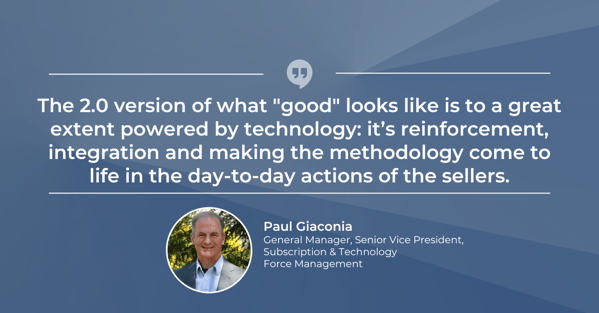
The Crucial Aspects of Leading Sales Teams Today
Categories: Sales Leadership | Sales Enablement Technology | Economic Change
Sometimes change comes in the form of a tidal wave: immediate, dramatic, and undeniable. More often, change happens slowly and steadily: hard to perceive until we’ve drifted so far from the shore that we can’t see where we started.
Whether you’re trying to minimize “drift” that’s occurred within your sales organization over time or respond to the immediate impact of the turbulent economic environment, ensure you’re focusing on crucial aspects that enable your team to succeed. Remain focused on the fundamental aspects of good selling while using every advantage to stay competitive in the modern selling landscape.
Sales 2.0 – What’s Changed
When the term Sales 2.0 appeared 15 years ago, it referred to the shift from interruption-based marketing to inbound: less doorknocking and more content-based offerings designed to generate leads by informing and connecting with audiences.
Today Sales 2.0 refers to the new playing field marked by constant connectivity with AI and automation. It’s all about data-driven decision-making informed by complex algorithms that sounded like science fiction only a few generations ago. Buyers expect reps to communicate virtually through multiple channels and want less face-to-face time than ever.
.png?width=2000&height=800&name=Technology%20Infographic%20v2%20(2000%20%C3%97%20800%20px).png)
Things have changed. The teams best equipped to be on top tomorrow are the ones that find ways to fuse the tried-and-true methods from the past with the new realities of today’s selling environment.
What Remains Crucial: Hiring and Developing the Right People
Tools and modes of communication have evolved, but the personality traits associated with top sales performers remain the same. Classic research still holds true: top performers score medium-high in empathy and ego drive. Too much empathy? They won’t be able to close deals. Too much ego drive? Being overly assertive turns people off. Not enough of either means they’re probably not built for sales. The best reps have a specific mix of both qualities.
The challenge for leaders is creating a repeatable process for hiring and retaining talent that will most likely thrive in their organization. Doing so starts with understanding the key traits necessary for success, and then building an operating model that supports managers with onboarding and coaching new hires. Hiring one elite heavy-hitter could make a big difference for a struggling team. However, retaining “perfect-fits” and upskilling your B players into A players across your teams will fundamentally transform a sales organization.
What Remains Crucial: The Core Fundamentals of Selling
Developing pipeline and moving prospects through the sales funnel remains as relevant as ever. Good prospecting and qualification are still where it all begins. Structured tools like MEDDICC help drive consistent discovery and qualify opportunities with precision that enhances your team’s efficiency.
The answers your sales reps uncover during qualification can then be used to frame the entire conversation with the five components of a successful sale. Whether face-to-face or virtual, the key components of customer-focused and value-based messaging continue to stand the test of time:
-
Show the potential buyer you understand their pain
-
Connect your solution to the organization’s biggest problem
-
Communicate from the buyer’s perspective
-
Introduce relevant competitive differences early in the cycle
- Articulate value clearly & consistently
Maximize the ROI your organization gets from your salesforce by ensuring everyone is aligned around a messaging framework designed to increase win rates and drive revenue.
How Leaders Can Enable Teams to Succeed
Two things leaders can do today to set their course for success are (1) adapt to the current economic climate and (2) harness the benefits available in the tech-oriented 2.0 playing field.
I. Adapt to The Current Economic Climate
Economic uncertainty means tighter budgets with longer decision-making processes and more people involved. As one tech executive predicted, “CFOs will be involved in every deal this year.”
Delivering a customer-focused message of value that connects to desired positive business outcomes – and solves the customer’s pain – is more important than ever. Reps must be versatile enough with messaging to navigate the buyer landscape and alter their sales message as needed. Train your reps to become audible-ready and versed in your messaging, so that they can adjust to different audiences within the buyer organization.
Teams can help themselves by enlisting champions to assist with moving the needle. Times like these mean multiple champions advocating at different places within the stakeholder team. Check out this clip from a recent Revenue Builder’s Podcast where Michael Cremen, CSO of Elastic, talks with co-host John McMahon about the questions reps can use for vetting and leveraging champions:
II. Harness the Benefits Available in the 2.0 Playing Field
The following four features of the 2.0 world provide new benefits to sellers and organizations; leaders should look for ways to leverage each one in today’s market:
The Power of Communities
The information age enables learning and networking in ways never before imagined. Birds of a feather flock to online groups to share tips or ask and answer questions. Platforms like Ascender offer a one-stop-shop for relevant content alongside curriculum and discussion forums where peers can share tricks of the trade, tools and best practices. If you’re an individual seller or lead a small team, learn how you can leverage this platform for growth.
Fostering Relationships in the Digital Age
Back in the day, the seller and manager hopped in the car together and met buyers in person, a whole day of interaction. Today, those communications happen over digital channels — a LinkedIn message or text, maybe a Zoom call.
Good leaders aren’t just arming their teams with the technology they need to communicate. They’re also enabling their managers with an operating rhythm that utilizes new tools and technology to coach reps effectively.
Top leaders know that interpersonal connection can’t be replaced and ensure this is still happening for their teams. They are considering how to connect their teams interpersonally and which events might offer critical face-to-face time with potential customers. Connection matters; developing these relationships requires more intention than it used to.
Data, Analytics & AI
Buyers and sellers are using these new tools on both sides. Buyers compare options and prices, and ratings. Sellers input data into Salesforce to make better targeted and educated decisions about what conversations to have with their potential customers.
Internally, leaders can ensure all the data entered into their CRM is captured in a way that aids coaching and professional development. Tools like Opportunity Manager reinforce the methodology and messaging in Salesforce, where reps spend the majority of their time. Guided assessments in Opportunity Manager help reps and managers qualify good opportunities and build sales and negotiation strategies around them.
New Modes of Continuous Learning and Reinforcement
The Forgetting Curve refers to research stating humans lose half of all new information after one day and 90% of new information within one week. This means once your team is aligned around a new initiative, each individual loses a little at each increment. Without reminders, we drift.
What can we do to combat forgetting everything our teams learn? Application and reinforcement; make it relevant and routine.
One good thing that came out of lockdowns and social distancing is the availability and mainstreaming of remote learning. Online digital content hubs like Ascender Plus offer coursework with assessments designed to fuel adoption and provide continuous learning.
Tools that empower managers to own their role in driving adoption can set you apart from the competition. These instruments empower your teams to drive efficiency with technology and ensure the core concepts of great selling.

Using Past and Present to Build Your Tomorrow
While times change and marketing landscapes shift, the fundamental ingredients of successful selling remain the same. We may use new tools or adopt new modes of communication, but a client-centered approach that conveys value and attaches to desired business outcomes remains at the core of any successful sales process.
Set your team up for success by bringing these two worlds together. Lead your organization into tomorrow by fusing the 2.0 realities of today with the timeless and battle-tested cornerstones of solid salesmanship. Use this guide to help your team increase win rates by delivering a powerful message of value.



